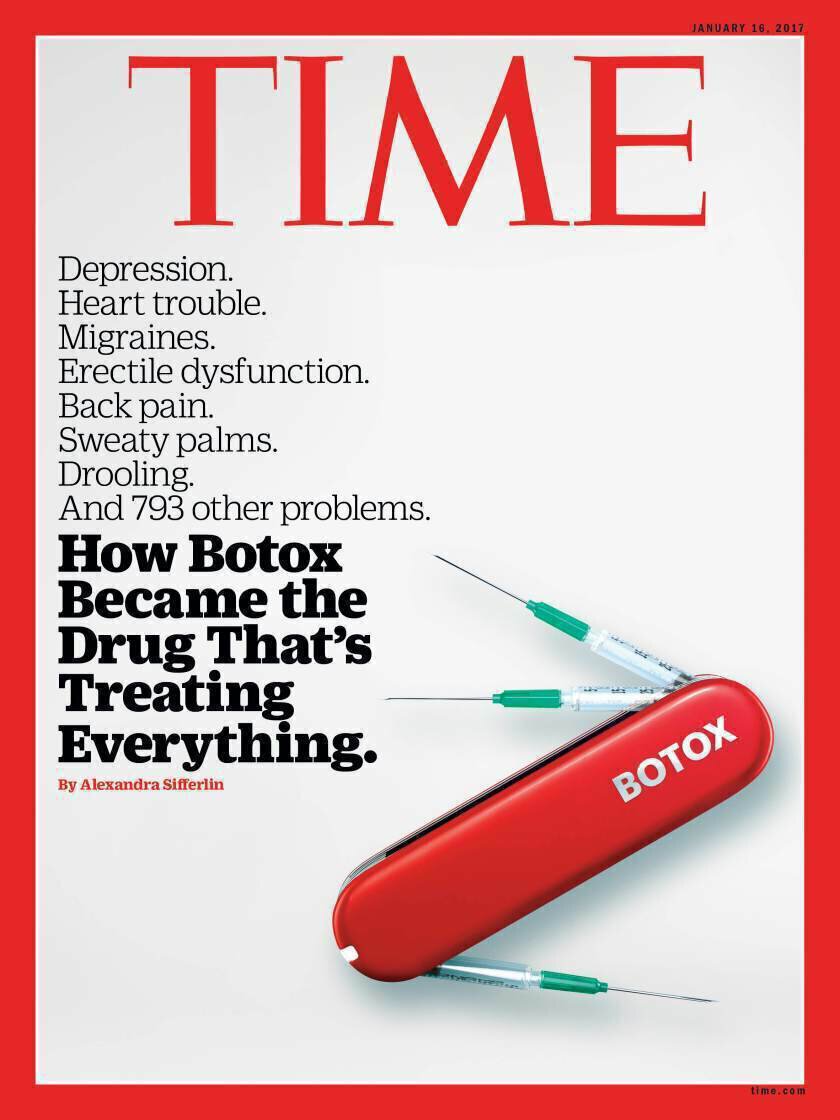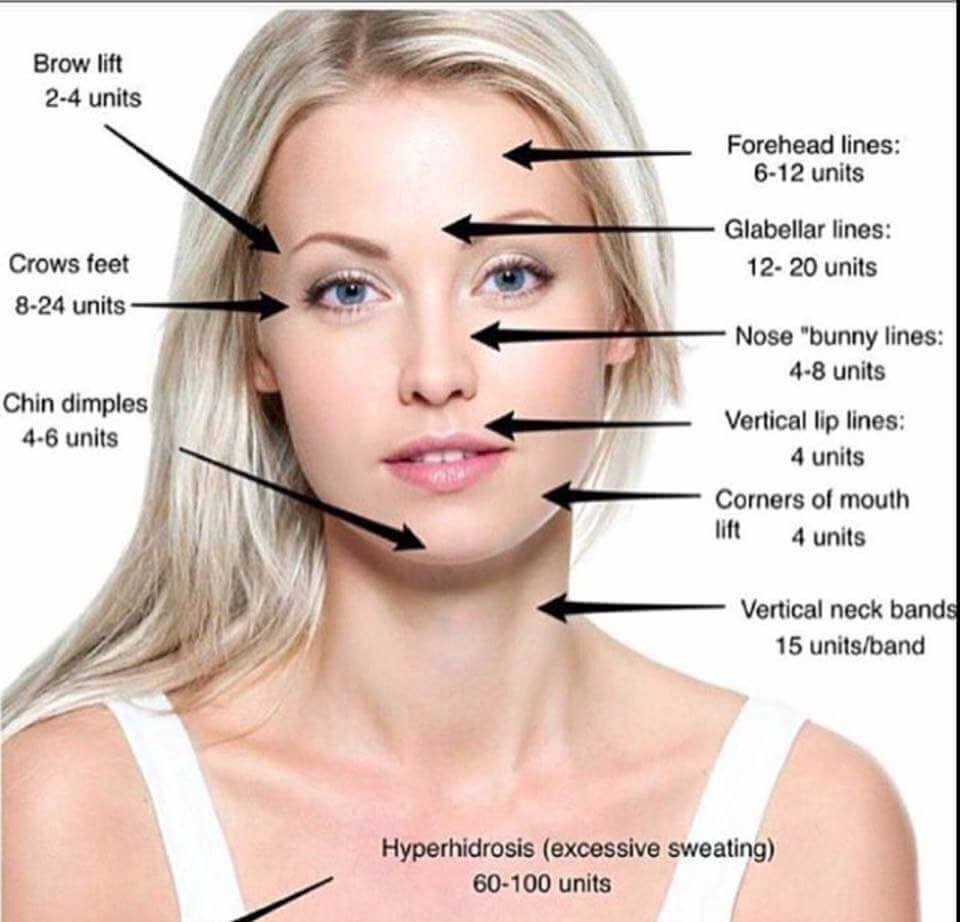
Hard to compete with a drug that is on the cover of Time magazine. Botox® is one of the most recognized pharmaceutical brands in the world.
Botox® and Xeomin® are the two main neuromodulators on the American market. They both work the exact same way. They both have the same core, active protein, and they both produce the same effect, which is muscle relaxation leading to removal of facial wrinkles. While there is no gold standard for treatment, Botox® is still the leading neuromodulator of choice in the United States, holding over 75% of the market. Xeomin® on the other hand is the fastest growing neuromodulator in the United States, reaching up to 15% of consumers in the United States.
While they both work the same way, there are a number of differences between Botox® and Xeomin®. These differerences don’t make one “better” than the other, but it has allowed our staff at Ocean Drive Plastic Surgery and MedSpa to combine treatments to get your best overall result.
Strengths of Each Neuromodulator – Botox
Brand Recognition – Advantage Botox®
Botox is without question a “household name”. It literally revolutionized Aesthetic Plastic Surgery and Dermatology, and continues to be used in novel fashions to improve aesthetics and wellness. Botox® recently received an FDA (United States Food and Drug Administration) indication for forehead lines, making Botox® the most widely approved injectable neuromodulator for the upper face. Botox is credited with defining and projecting the concept of the “11’s”.
Botox® has over thirty years of clinical success to its credit. For the last fifteen years, injections of Botulinum toxin Type A continues has been the most common medical cosmetic procedure in the United States, and its prevalence and popularity continue to grow in the United States.
Preservative Free/Purified Product – Advantage Xeomin®
Botox and Xeomin share a common core molecule. However, Botox® is complexed with a preservative protein while Xeomin represents a purer form of neuromodulator. Xeomin® goes through a proprietary cleansing process where un-necessary preservative proteins are removed. This unique purification process makes Xeomin a directly available molecule after injected. Because of this, Xeomin starts working within 24 hours, while Botox can take up to 2 weeks for maximal effect. This makes Xeomin® the unparalleled choice for last minute “event fabulous” needs, and first choice therapy for anyone who is interested in reducing exposure to unnecessary preservatives.
European Marketshare – Advantage Xeomin
As compared to Botox®, Xeomin® is literally David vs. Goliath, but only in the United States!! In the European market, Xeomin represents nearly 80% of the market, while Botox® is in the minority of market share. Also, while Xeomin® does not have an FDA indication for the forehead, it is considered first-line therapy over Botox® for blepharospasm per the FDA.
Clinical Effect – Botox and Xeomin are Equal! A tie!
The core molecule for both Botox® and Xeomin® is nearly identical, although they come from different strains of bacteria. They both work the exact same way. After injection, the neuromodulator molecule binds presynaptically, disallowing release of acetycholine at the motor end plate. This results in muscle paralysis, allowing for release and resolution of animational rhytids (aka, wrinkles from movement). While Botox® made this effect famous, the effect created by Xeomin is nearly identical to that of its famous predecessor. Both neuromodulators can be used to release and smooth the glabellar 11’s, forehead lines, crows feet, and chin wrinkles. They can both be used for masseteric reduction in the face, and for chemical brow lifting. Dosing for Botox® is comparable to Xeomin®. In other words, 40 units of Botox® is the same strength as 40 units of Xeomin®.
Units needed for treatment – A tie!
As previously mentioned, the uses for Botox® and Xeomin® are the same. They are both used for chemical brow lifts, reduction of glabellar lines (the 11’s), reduction of forehead lines, reduction of crow’s feet, hyperhidrosis, blepharospasm, and migraine. They can be also used to reduce TMJ pain, and alleviate chin wrinkles. Both treatments can also be used for reduction of the masseteric muscles.
The chart below shows the beginning, standard dosing for Botox® and Xeomin®. Many people require more, or less than what is shown, but this chart gives.a good overview of what kind of dosing is generally required to exert the appropriate clincal effect.

Diagram shown here shows baseline dosing for Botox® and Xeomin®. Note the similiarities in dosing between the two platforms.
Duration of Action – Botox and Xeomin are Equal! A tie!!
Both Botox® and Xeomin® have an average effective period of 90 days. The one primary difference to note is that after injection, Xeomin is immediately bioavailable because of its preservative-free molecular makeup. It starts to set its effect within 24 hours. Botox, however, is complexed to a preservative protein. Before Botox® starts to work, it has to cleave itself from its preservative protein, and then bind to the cholinergic nerve fiber endplate. This process results in a latency period of 5-14 days for Botox® injections. In other words, Botox takes longer to get started in its effect, but they both last the same amount of time. Its just that Xeomin starts immediately, and Botox takes at least a week to start its effect. Because of its immediate onset, Xeomin is our “event fabulous”, or “emergency” neuromodulator. It starts working immediately, so for people with time constraints, Xeomin® tends to work out really well. This isn’t a real advantage, in our opinion, just a neat difference between the two platforms.
Post Op Instructions:
General Aftercare
The day you get Botox, it’s a good idea to:
- Gently exercise your face (smiling, frowning, and raising eyebrows)
- Relax for the rest of the day
- Maintain a normal heart rate
- Avoid touching, rubbing, or physical pressure on the affected area
- Leave the treated area alone
- Sit up for the first 4 hours after getting Botox. Bending or lying down might spread the toxin and promote bruising. Also, avoid sleeping the first 4 hours after procedure
Things to Avoid the First 24-48 Hours:
- Sun/Heat exposure
- Touching face or area that was treated
- Consuming alcohol
- Applying makeup
- Any Physical Activities
Discomfort
Some may experience discomfort at the injection site, while others may get a headache after an injection. This discomfort is typically minor and can be treated with acetaminophen (Tylenol). Ibuprofen (Advil, Motrin), aspirin, naproxen (Aleve), and other nonsteroidal anti-inflammatory drugs (NSAIDs) are not recommended as these can increase bruising. Cold compresses such as soft washcloths or the ice packs that we provide to you can be used to help relieve some of the discomfort as well.
Swelling & Bruising
To reduce swelling and bruising on injection site apply ice to area for 15 minutes every hour.
Sleeping
Try your best to avoid sleeping on the injected areas. This will minimize the physical pressure and let the Botox settle into your muscles.
Finally
Neuromodulators will gradually take effect over 2-10 days with optimum results at 2 weeks. Consult with your injector about recommendations for touch-up or follow up treatments. If this is your first Botox injection, we recommend scheduling a follow up appointment 2 weeks after your injection. Touch-ups are very common with neuromodulator therapy.











